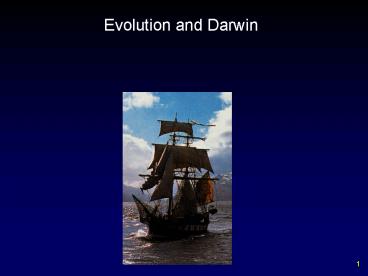Evolution and Darwin - PowerPoint PPT Presentation
1 / 14
Title:
Evolution and Darwin
Description:
One could tell which island a tortoise came from by the shape of its shell. Why? 6. Tortoises of the Galapagos. Pinta Island. Isabela Island. Hood Island. 7. Darwin ... – PowerPoint PPT presentation
Number of Views:32
Avg rating:3.0/5.0
Title: Evolution and Darwin
1
Evolution and Darwin
2
Theories
- A theory is
- a proposed explanation for a natural phenomenon.
- the body of interconnected concepts, supported by
scientific reasoning and experimental evidence.
(Lots and Lots of Evidence) - solid ground of science
- A theory is a hypothesis that has not been
rejected through experimentation and is a
predictable phenomenon
3
Charles Darwin
- Served as naturalist on mapping expedition around
coastal South America and the world in 1831-1836. - He traveled on the HMS Beagle
- Through observations and collected evidence
during his voyage and 25 plus years of
experimentation in England Darwin - -Argued operation of natural laws
- produced change over time, evolution.
- -explained by natural selection
4
Charles Darwin
5
Darwins Evidence
- Fossils of extinct organisms were similar to
modern species. Why had so many of these species
disappeared? - Characteristics of similar species varied from
place to place. Why were there no rabbits in
Australia? Why were there no kangaroos in
England? - Organisms on young volcanic islands (Galapagos)
resembled those on mainland coast. Why? - One could tell which island a tortoise came from
by the shape of its shell. Why?
6
Tortoises of the Galapagos
Pinta Island
Isabela Island
Hood Island
7
Darwin
- Darwin suggested individuals with superior
physical or behavioral traits are more likely to
survive and reproduce, the struggle for
existence, than those without such attributes. - Selection
- artificial - domesticated breeds
- Corn
- Dogs
- natural - organisms in the wild
- Alfred Russel Wallace independently and almost
simultaneously developed same idea 1858.
8
Ideas that shaped Darwins Work
- James Hutton (1795) and Charles Lyell (1830)
- Geologists that described how the earth is very
old can slowly change over long periods of time - Jean-Baptiste Lamarck (1809)
- One of first to recognize living things have
changed over time. - Tendency towards perfection
- Use and Disuse
- Inheritance of Acquired Traits
- Thomas Malthus (1798)
- Observed human population growth and what
controls it (war, famine, disease) - Darwin applied his ideas to other species. Why do
some individuals survive and reproduce and others
do not?
9
Darwin Finally Publishes His Work
- Published in 1859
- On the Origin of Species by Means of Natural
Selection, or the Preservation of Favoured Races
in the Struggle for Life
10
Post-Darwin Evolution Evidence
- Fossil record
- Earth is older than previously believed
- Showed how species had changed and produced
different species over time - Geographic Distribution of Living Species
- Species on different continents with different
ancestors, living in similar environments shared
similar characteristics - Mechanisms of Heredity
- modern genetics
- DNA
11
Post-Darwin Evolution Evidence cont.
Molecular Evidence Molecular
Clocks Pylogenetic Trees
12
Post-Darwin Evolution Evidence
- Comparative anatomy
- Homologous structures
- Have same evolutionary origin, but different
structure and function. - Analogous structures
- Have similar structure and function, but
different evolutionary origin.
13
Homology Among Vertebrate Limbs
Analogous structures
14
Summary of Darwins Theory
- Individual organisms differ, and some of this
variation is heritable. - Organisms produce more offspring than can
survive, and many that do survive do not
reproduce - Because more organisms are produced than can
survive, they compete for limited resources. - Each unique organism has different advantages and
disadvantages in the struggle for existence - Species alive today are descended with
modification from ancestral species that lived in
the distant past. All from a common ancestor. A
single tree of life

